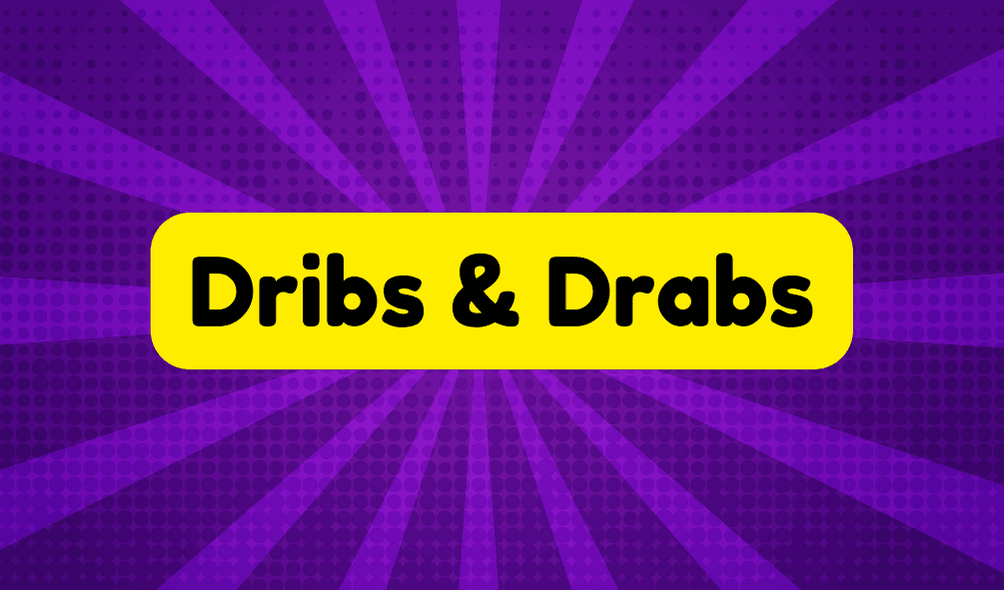The phrase "dribs and drabs" signifies the slow, irregular accumulation of small amounts, often leading to inefficiency and frustration in various contexts. Its origin is unclear, likely arising from colloquial language over time. Examples include earnings or information received in fragments, highlighting the challenges of consistent progress. While the phrase serves as a critique of modern expectations for quick results, it remains relevant. Those who seek further understanding will find deeper insights into its nuances and applications.
Synonyms
When exploring synonyms for the expression "dribs and drabs," one may encounter terms like "bits," "pieces," and "crumbs." These alternatives capture the essence of small, irregular quantities but may lack the same connotation of gradual accumulation. In the domain of progress updates and gradual improvements, such terms can feel insufficient. They often fail to convey the frustrating reality of slow advancement. Consider these three clarifying options:
- Incremental steps
- Fragmented progress
- Scattered outputs
These phrases better illustrate the hurdles often faced in attempts to achieve meaningful outcomes amidst a backdrop of inconsistency and uneven quality.
Example of Sentences
The phrase "dribs and drabs" can be illustrated through a variety of sentences that capture its meaning and nuances. This phrase gains relevance in both creative processes and financial management, highlighting the importance of gradual progress. Consider the following examples:
- New projects often receive feedback in dribs and drabs, impeding innovation.
- In financial management, savings may accumulate in dribs and drabs, delaying significant investments.
- The artist completed her masterpiece in dribs and drabs, reflecting her struggle for consistency.
These sentences emphasize how the slow accumulation of effort or earnings can lead to frustration, questioning the efficiency of both methods.
Origin
Understanding the origin of the phrase "dribs and drabs" proves challenging, as its history remains largely obscure. Its emergence likely stems from colloquial usage, evolving through informal conversations over time. While specific historical usage examples are scarce, similar idiomatic expressions often lack well-defined roots. This ambiguity raises questions about authenticity and cultural significance. The phrase suggests a gradual accumulation of small bits, hinting at an inefficient process. Ultimately, the unclear origins of this expression reflect the complexities of language, where words often grow apart from their initial meanings, leaving users with a curious blend of familiarity and uncertainty.
Collocations
Collocations related to the phrase "dribs and drabs" provide insight into how the expression functions in various contexts. By examining common pairings, one can see how it captures themes of unpredictable progress and gradual improvement. Importantly, these collocations include:
- Earnings in dribs and drabs – indicating a slow financial recovery.
- Information received in dribs and drabs – emphasizing frustrating delays in updates.
- Work completed in dribs and drabs – highlighting inconsistent productivity in projects.
Such expressions reflect a reality where change occurs slowly, often leaving one to ponder the effectiveness of efforts invested.
How to Use in Everyday Language
Using the phrase "dribs and drabs" in everyday language can effectively convey a sense of frustration with slow or inconsistent progress. It serves as one of many phrases to use when discussing tasks that seem to drag on indefinitely. In casual conversations, individuals might express weariness over a project yielding results in dribs and drabs. This phrase highlights not only inefficiency but also a potential lack of motivation. By incorporating "dribs and drabs," speakers can communicate their dissatisfaction with a situation without sounding overly harsh, making it an insightful choice for those maneuvering the intricacies of modern challenges.
Why Is It Still Relevant Today?
Although modern society often demands efficiency and quick results, the expression "dribs and drabs" remains relevant as it aptly captures the reality of many people's experiences with gradual progress. This idiom effectively illustrates moments when efforts yield results slowly, often highlighting inefficient processes. In a world that prizes instant gratification, recognizing the power of gradual accumulation can offer a healthier perspective on progress. It serves as a reminder that meaningful achievements frequently unfold over time, countering the impatience prevalent in contemporary culture. Hence, "dribs and drabs" resonates not only as a description but as a contemplative critique of modern expectations.







